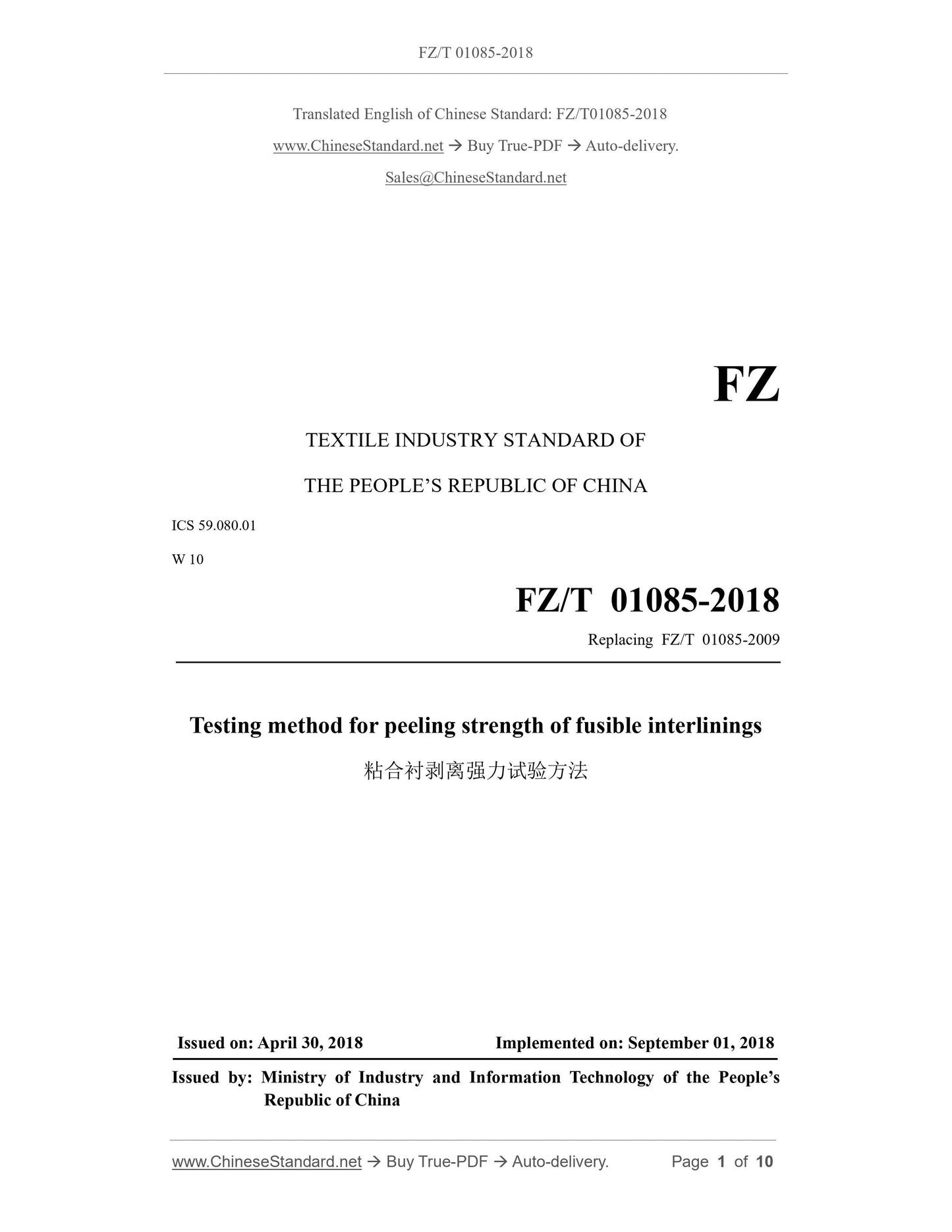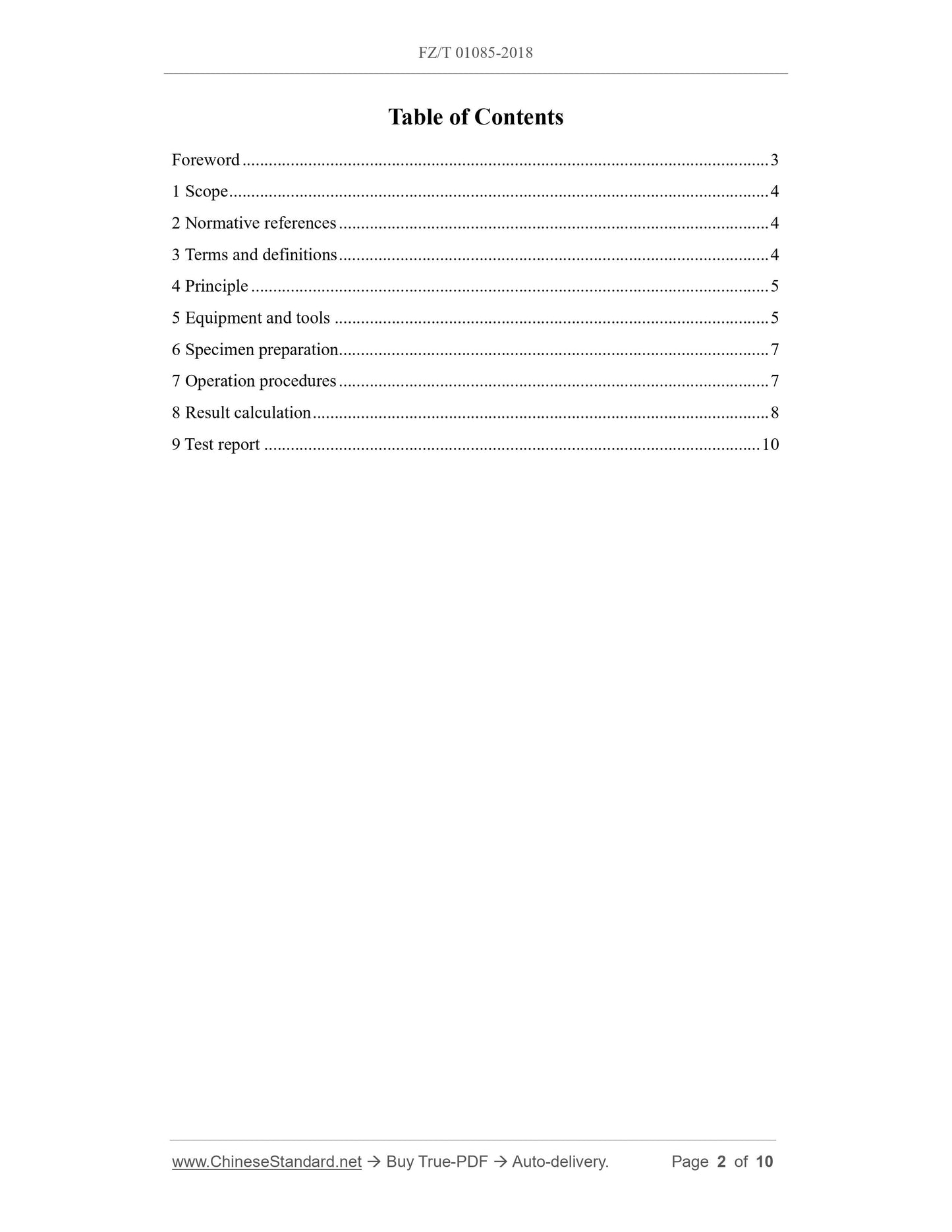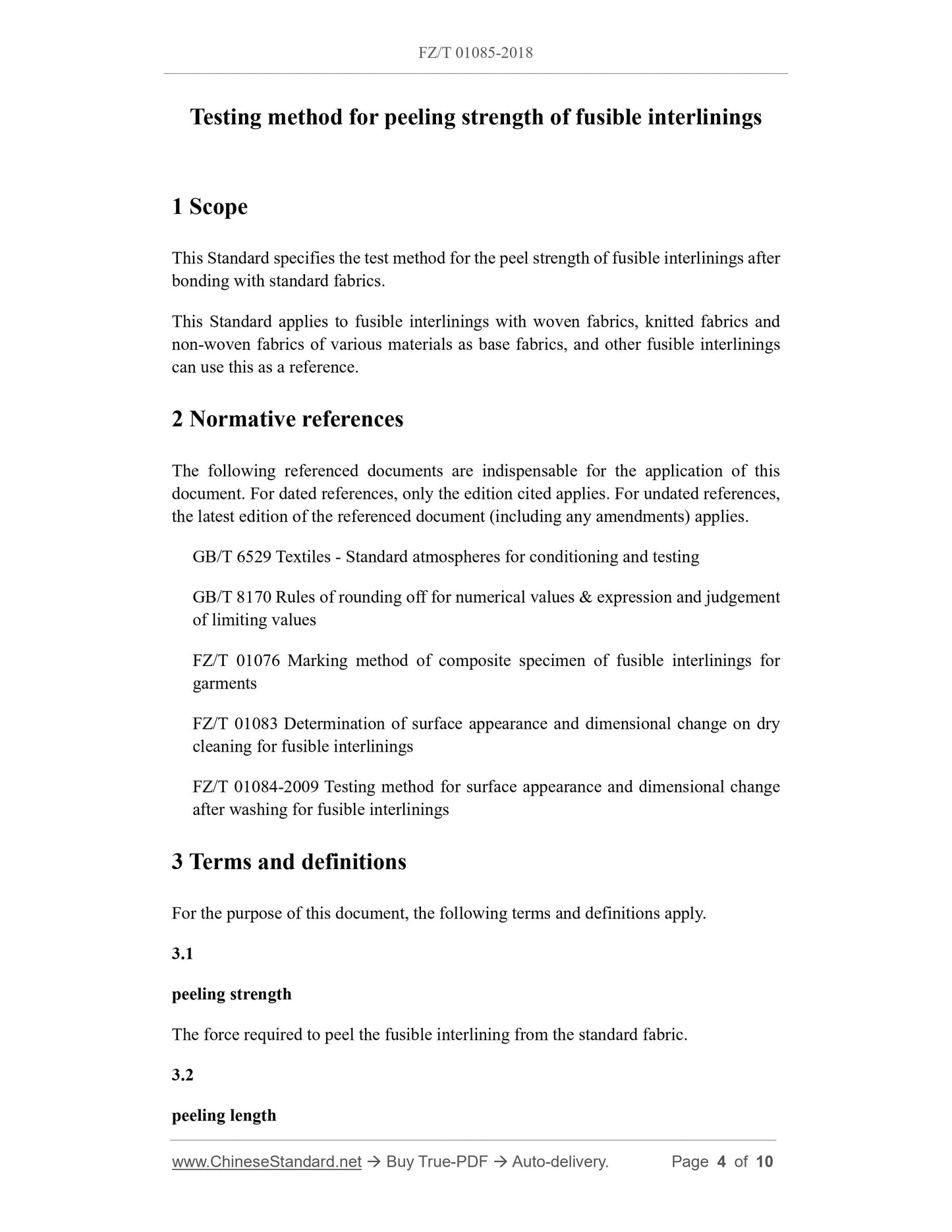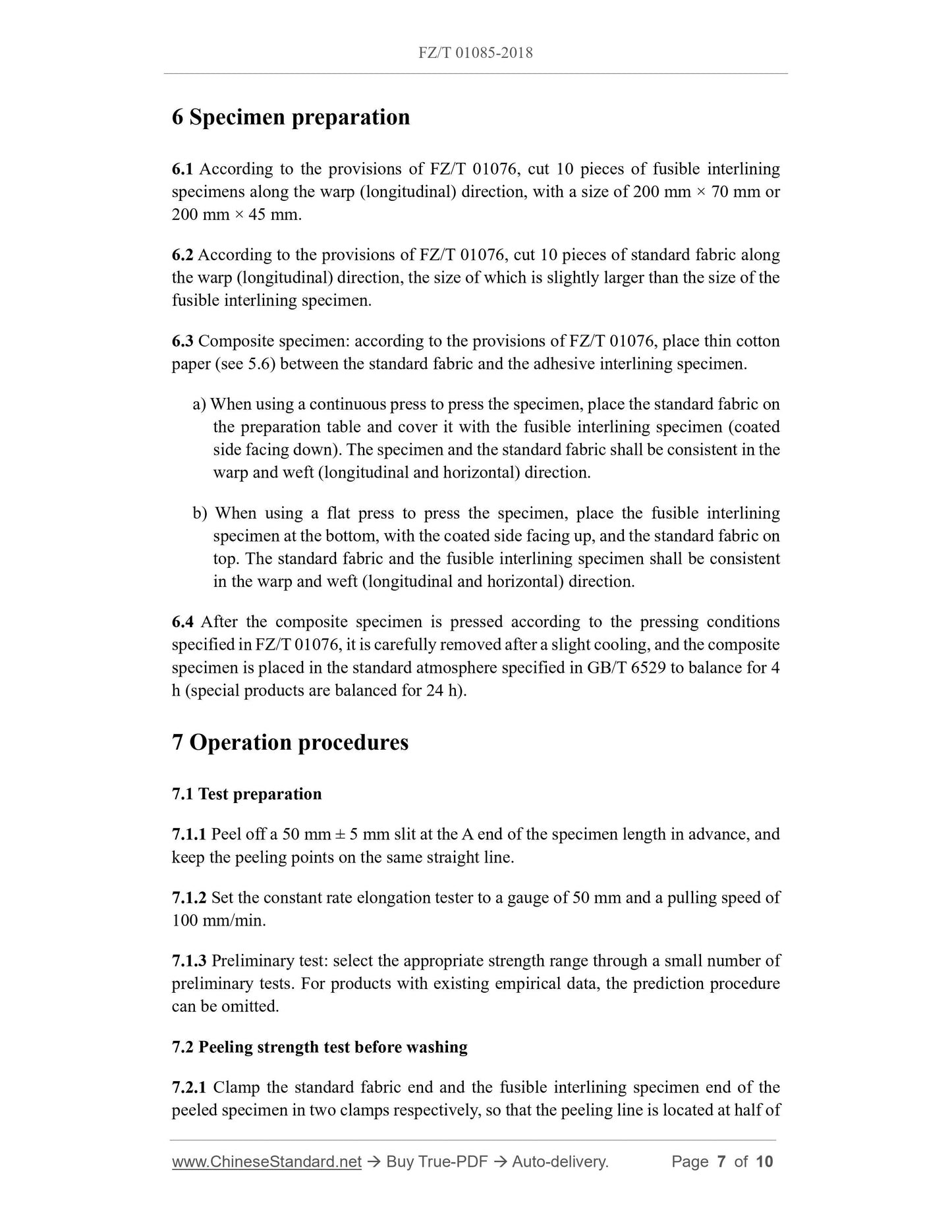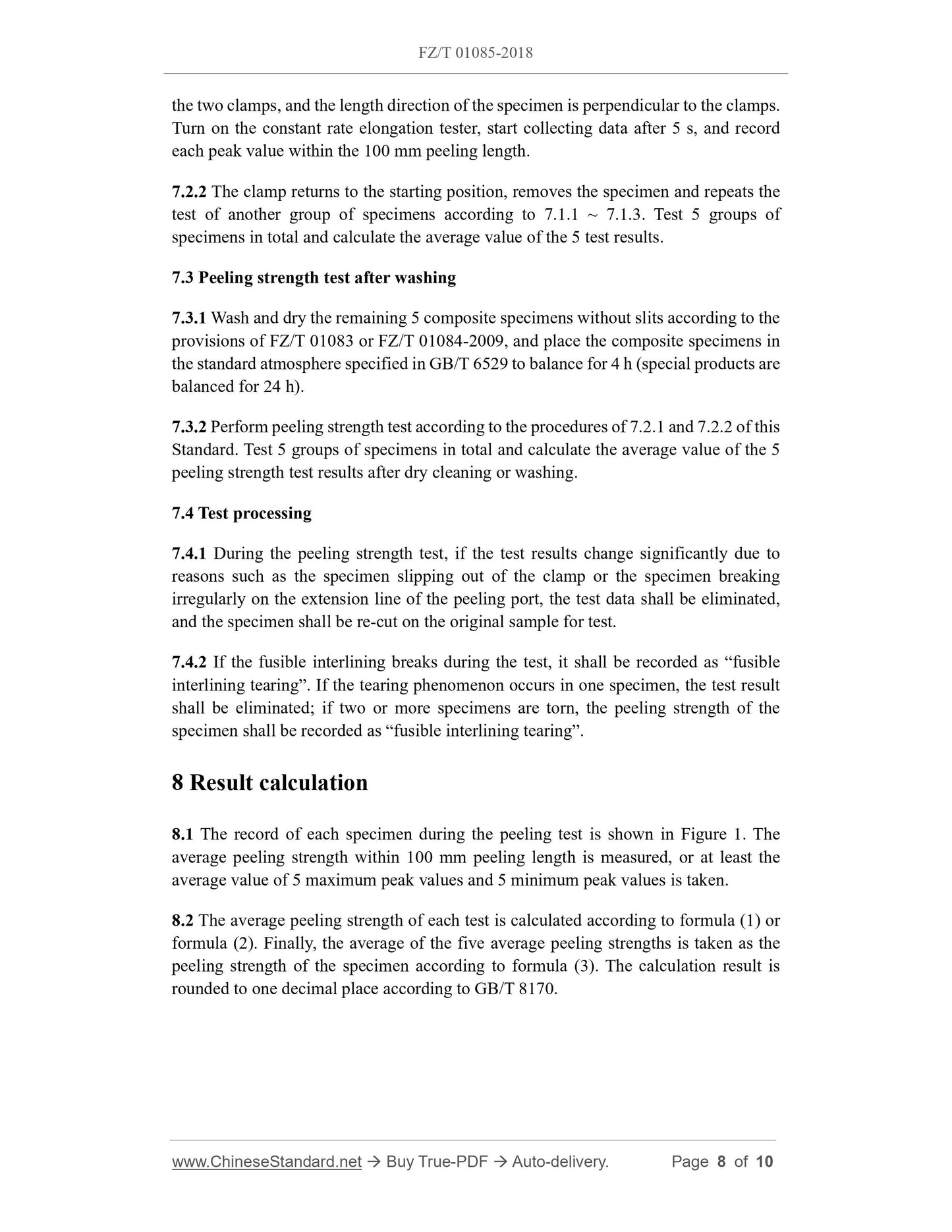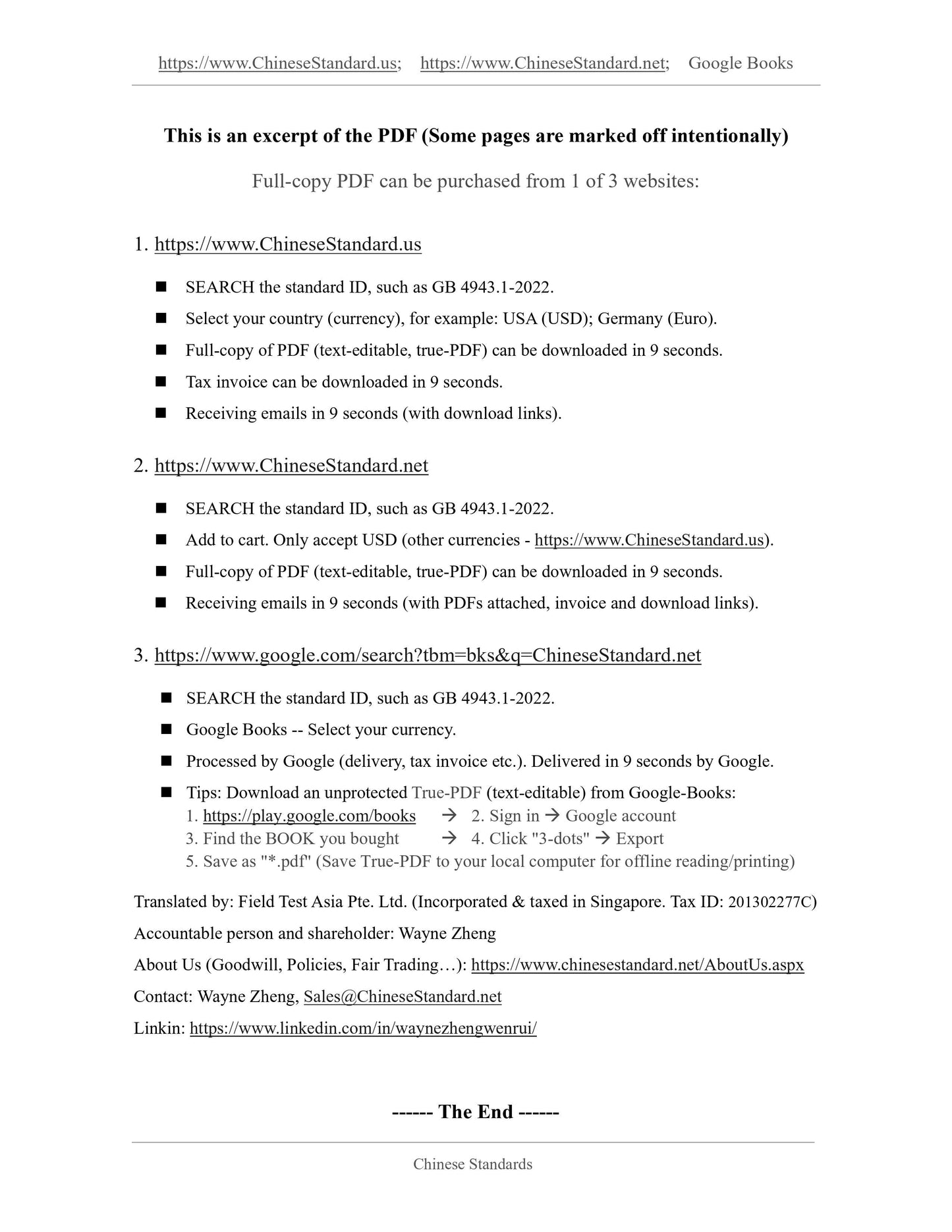1
/
su
6
PayPal, credit cards. Download editable-PDF and invoice in 1 second!
FZ/T 01085-2018 English PDF (FZT01085-2018)
FZ/T 01085-2018 English PDF (FZT01085-2018)
Prezzo di listino
$125.00 USD
Prezzo di listino
Prezzo scontato
$125.00 USD
Prezzo unitario
/
per
Spese di spedizione calcolate al check-out.
Impossibile caricare la disponibilità di ritiro
Delivery: 3 seconds. Download true-PDF + Invoice.
Get QUOTATION in 1-minute: Click FZ/T 01085-2018
Historical versions: FZ/T 01085-2018
Preview True-PDF (Reload/Scroll if blank)
FZ/T 01085-2018: Testing method for peeling strength of fusible interlinings
FZ/T 01085-2018
FZ
TEXTILE INDUSTRY STANDARD OF
THE PEOPLE’S REPUBLIC OF CHINA
ICS 59.080.01
W 10
Replacing FZ/T 01085-2009
Testing method for peeling strength of fusible interlinings
ISSUED ON. APRIL 30, 2018
IMPLEMENTED ON. SEPTEMBER 01, 2018
Issued by. Ministry of Industry and Information Technology of the People’s
Republic of China
Table of Contents
Foreword... 3
1 Scope... 4
2 Normative references... 4
3 Terms and definitions... 4
4 Principle... 5
5 Equipment and tools... 5
6 Specimen preparation... 7
7 Operation procedures... 7
8 Result calculation... 8
9 Test report... 10
Testing method for peeling strength of fusible interlinings
1 Scope
This Standard specifies the test method for the peel strength of fusible interlinings after
bonding with standard fabrics.
This Standard applies to fusible interlinings with woven fabrics, knitted fabrics and
non-woven fabrics of various materials as base fabrics, and other fusible interlinings
can use this as a reference.
2 Normative references
The following referenced documents are indispensable for the application of this
document. For dated references, only the edition cited applies. For undated references,
the latest edition of the referenced document (including any amendments) applies.
GB/T 6529 Textiles - Standard atmospheres for conditioning and testing
GB/T 8170 Rules of rounding off for numerical values and expression and judgement
of limiting values
FZ/T 01076 Marking method of composite specimen of fusible interlinings for
garments
FZ/T 01083 Determination of surface appearance and dimensional change on dry
cleaning for fusible interlinings
FZ/T 01084-2009 Testing method for surface appearance and dimensional change
after washing for fusible interlinings
3 Terms and definitions
For the purpose of this document, the following terms and definitions apply.
3.1
peeling strength
The force required to peel the fusible interlining from the standard fabric.
3.2
peeling length
6 Specimen preparation
6.1 According to the provisions of FZ/T 01076, cut 10 pieces of fusible interlining
specimens along the warp (longitudinal) direction, with a size of 200 mm × 70 mm or
200 mm × 45 mm.
6.2 According to the provisions of FZ/T 01076, cut 10 pieces of standard fabric along
the warp (longitudinal) direction, the size of which is slightly larger than the size of the
fusible interlining specimen.
6.3 Composite specimen. according to the provisions of FZ/T 01076, place thin cotton
paper (see 5.6) between the standard fabric and the adhesive interlining specimen.
a) When using a continuous press to press the specimen, place the standard fabric on
the preparation table and cover it with the fusible interlining specimen (coated
side facing down). The specimen and the standard fabric shall be consistent in the
warp and weft (longitudinal and horizontal) direction.
b) When using a flat press to press the specimen, place the fusible interlining
specimen at the bottom, with the coated side facing up, and the standard fabric on
top. The standard fabric and the fusible interlining specimen shall be consistent
in the warp and weft (longitudinal and horizontal) direction.
6.4 After the composite specimen is pressed according to the pressing conditions
specified in FZ/T 01076, it is carefully removed after a slight cooling, and the composite
specimen is placed in the standard atmosphere specified in GB/T 6529 to balance for 4
h (special products are balanced for 24 h).
7 Operation procedures
7.1 Test preparation
7.1.1 Peel off a 50 mm ± 5 mm slit at the A end of the specimen length in advance, and
keep the peeling points on the same straight line.
7.1.2 Set the constant rate elongation tester to a gauge of 50 mm and a pulling speed of
100 mm/min.
7.1.3 Preliminary test. select the appropriate strength range through a small number of
preliminary tests. For products with existing empirical data, the prediction procedure
can be omitted.
7.2 Peeling strength test before washing
7.2.1 Clamp the standard fabric end and the fusible interlining specimen end of the
peeled specimen in two clamps respectively, so that the peeling line is located at half of
the two clamps, and the length direction of the specimen is perpendicular to the clamps.
Turn on the constant rate elongation tester, start collecting data after 5 s, and record
each peak value within the 100 mm peeling length.
7.2.2 The clamp returns to the starting position, removes the specimen and repeats the
test of another group of specimens according to 7.1.1 ~ 7.1.3.Test 5 groups of
specimens in total and calculate the average value of the 5 test results.
7.3 Peeling strength test after washing
7.3.1 Wash and dry the remaining 5 composite specimens without slits according to the
provisions of FZ/T 01083 or FZ/T 01084-2009, and place the composite specimens in
the standard atmosphere specified in GB/T 6529 to balance for 4 h (special products are
balanced for 24 h).
7.3.2 Perform peeling strength test according to the procedures of 7.2.1 and 7.2.2 of this
Standard. Test 5 groups of specimens in total and calculate the average value of the 5
peeling strength test results after dry cleaning or washing.
7.4 Test processing
7.4.1 During the peeling strength test, if the test results change significantly due to
reasons such as the specimen slipping out of the clamp or the specimen breaking
irregularly on the extension line of the peeling port, the test data shall be eliminated,
and the specimen shall be re-cut on the original sample for test.
7.4.2 If the fusible interlining breaks during the test, it shall be recorded as “fusible
interlining tearing”. If the tearing phenomenon occurs in one specimen, the test result
shall be eliminated; if two or more specimens are torn, the peeling strength of the
specimen shall be recorded as “fusible interlining tearing”.
8 Result calculation
8.1 The record of each specimen during the peeling test is shown in Figure 1.The
average peeling strength within 100 mm peeling length is measured, or at least the
average value of 5 maximum peak values and 5 minimum peak values is taken.
8.2 The average peeling strength of each test is calculated according to formula (1) or
formula (2). Finally, the average of the five average peeling strengths is taken as the
peeling strength of the specimen according to formula (3). The calculation result is
rounded to one decimal place according to GB/T 8170.
Get QUOTATION in 1-minute: Click FZ/T 01085-2018
Historical versions: FZ/T 01085-2018
Preview True-PDF (Reload/Scroll if blank)
FZ/T 01085-2018: Testing method for peeling strength of fusible interlinings
FZ/T 01085-2018
FZ
TEXTILE INDUSTRY STANDARD OF
THE PEOPLE’S REPUBLIC OF CHINA
ICS 59.080.01
W 10
Replacing FZ/T 01085-2009
Testing method for peeling strength of fusible interlinings
ISSUED ON. APRIL 30, 2018
IMPLEMENTED ON. SEPTEMBER 01, 2018
Issued by. Ministry of Industry and Information Technology of the People’s
Republic of China
Table of Contents
Foreword... 3
1 Scope... 4
2 Normative references... 4
3 Terms and definitions... 4
4 Principle... 5
5 Equipment and tools... 5
6 Specimen preparation... 7
7 Operation procedures... 7
8 Result calculation... 8
9 Test report... 10
Testing method for peeling strength of fusible interlinings
1 Scope
This Standard specifies the test method for the peel strength of fusible interlinings after
bonding with standard fabrics.
This Standard applies to fusible interlinings with woven fabrics, knitted fabrics and
non-woven fabrics of various materials as base fabrics, and other fusible interlinings
can use this as a reference.
2 Normative references
The following referenced documents are indispensable for the application of this
document. For dated references, only the edition cited applies. For undated references,
the latest edition of the referenced document (including any amendments) applies.
GB/T 6529 Textiles - Standard atmospheres for conditioning and testing
GB/T 8170 Rules of rounding off for numerical values and expression and judgement
of limiting values
FZ/T 01076 Marking method of composite specimen of fusible interlinings for
garments
FZ/T 01083 Determination of surface appearance and dimensional change on dry
cleaning for fusible interlinings
FZ/T 01084-2009 Testing method for surface appearance and dimensional change
after washing for fusible interlinings
3 Terms and definitions
For the purpose of this document, the following terms and definitions apply.
3.1
peeling strength
The force required to peel the fusible interlining from the standard fabric.
3.2
peeling length
6 Specimen preparation
6.1 According to the provisions of FZ/T 01076, cut 10 pieces of fusible interlining
specimens along the warp (longitudinal) direction, with a size of 200 mm × 70 mm or
200 mm × 45 mm.
6.2 According to the provisions of FZ/T 01076, cut 10 pieces of standard fabric along
the warp (longitudinal) direction, the size of which is slightly larger than the size of the
fusible interlining specimen.
6.3 Composite specimen. according to the provisions of FZ/T 01076, place thin cotton
paper (see 5.6) between the standard fabric and the adhesive interlining specimen.
a) When using a continuous press to press the specimen, place the standard fabric on
the preparation table and cover it with the fusible interlining specimen (coated
side facing down). The specimen and the standard fabric shall be consistent in the
warp and weft (longitudinal and horizontal) direction.
b) When using a flat press to press the specimen, place the fusible interlining
specimen at the bottom, with the coated side facing up, and the standard fabric on
top. The standard fabric and the fusible interlining specimen shall be consistent
in the warp and weft (longitudinal and horizontal) direction.
6.4 After the composite specimen is pressed according to the pressing conditions
specified in FZ/T 01076, it is carefully removed after a slight cooling, and the composite
specimen is placed in the standard atmosphere specified in GB/T 6529 to balance for 4
h (special products are balanced for 24 h).
7 Operation procedures
7.1 Test preparation
7.1.1 Peel off a 50 mm ± 5 mm slit at the A end of the specimen length in advance, and
keep the peeling points on the same straight line.
7.1.2 Set the constant rate elongation tester to a gauge of 50 mm and a pulling speed of
100 mm/min.
7.1.3 Preliminary test. select the appropriate strength range through a small number of
preliminary tests. For products with existing empirical data, the prediction procedure
can be omitted.
7.2 Peeling strength test before washing
7.2.1 Clamp the standard fabric end and the fusible interlining specimen end of the
peeled specimen in two clamps respectively, so that the peeling line is located at half of
the two clamps, and the length direction of the specimen is perpendicular to the clamps.
Turn on the constant rate elongation tester, start collecting data after 5 s, and record
each peak value within the 100 mm peeling length.
7.2.2 The clamp returns to the starting position, removes the specimen and repeats the
test of another group of specimens according to 7.1.1 ~ 7.1.3.Test 5 groups of
specimens in total and calculate the average value of the 5 test results.
7.3 Peeling strength test after washing
7.3.1 Wash and dry the remaining 5 composite specimens without slits according to the
provisions of FZ/T 01083 or FZ/T 01084-2009, and place the composite specimens in
the standard atmosphere specified in GB/T 6529 to balance for 4 h (special products are
balanced for 24 h).
7.3.2 Perform peeling strength test according to the procedures of 7.2.1 and 7.2.2 of this
Standard. Test 5 groups of specimens in total and calculate the average value of the 5
peeling strength test results after dry cleaning or washing.
7.4 Test processing
7.4.1 During the peeling strength test, if the test results change significantly due to
reasons such as the specimen slipping out of the clamp or the specimen breaking
irregularly on the extension line of the peeling port, the test data shall be eliminated,
and the specimen shall be re-cut on the original sample for test.
7.4.2 If the fusible interlining breaks during the test, it shall be recorded as “fusible
interlining tearing”. If the tearing phenomenon occurs in one specimen, the test result
shall be eliminated; if two or more specimens are torn, the peeling strength of the
specimen shall be recorded as “fusible interlining tearing”.
8 Result calculation
8.1 The record of each specimen during the peeling test is shown in Figure 1.The
average peeling strength within 100 mm peeling length is measured, or at least the
average value of 5 maximum peak values and 5 minimum peak values is taken.
8.2 The average peeling strength of each test is calculated according to formula (1) or
formula (2). Finally, the average of the five average peeling strengths is taken as the
peeling strength of the specimen according to formula (3). The calculation result is
rounded to one decimal place according to GB/T 8170.
Share
